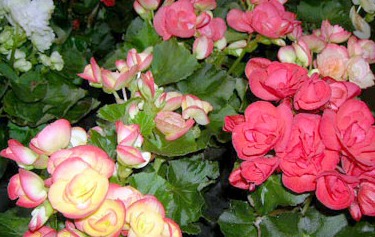Growing Begonias
Plant Care Tips and Information
Growing begonia plants is easy when you take to time to select the plants that match the growing environment in your home or landscape.
Begonias vary in size and longevity, as well as leaf and flower shape.
Angel Wing begonias are popular houseplants due their attractive leaves and colorful flowers. They are long-lived and can be propagated easily by rooting stem cuttings.
Rex Begonias are harder to grow; however, their unique
 stained-glass
leaves make a striking display.
stained-glass
leaves make a striking display.Reiger Begonias are used for short-lived color, commonly displayed on windowsills. When the flowers fade they can be propagated from rooted stem cuttings or discarded.
The Wax Begonia is known for its round, thick, waxy leaves – giving this colorful flowering plant its common name.
Growing Begonias – Basic Tips for Begonia Care
- Begonias are sensitive to extreme changes to their environment. Try to purchase them from a local florist or nursery. If the plant must be shipped, warm weather conditions are preferable.
- When you bring begonias home, keep them protected from drafts and dry conditions by enclosing them in a loose plastic bag for the first few days. It is important to handle begonias with care in the first few weeks to encourage longevity.
- Begonia plants are easy to propagate – simply set stem tip cuttings to root in a warm, humid environment. Some species can be grown from seed; however, the easiest method is by rooting stem cuttings or leaves.
- Avoid problems with overwatering and root rot by planting begonias in compact flower pots.
- Begonias commonly suffer from over-watering, as well as extremely dry soil. A general rule of thumb is to allow the top inch of soil to become almost dry between watering; although water requirements will vary by species.
- Begonias require moderate to dry humidity. Humidity can be easily provided by setting the flower pots on a tray of pebbles filled with water, or by placing plants near a humidifier.
Note: Begonia care requirements can vary, depending on the species. Be sure to review the requirements that are specific to your plant.
Growing Begonias - Solutions to Common Problems
Leaves turn yellow or brown and fall off.Cause: Overwatering
Solution: Keep begonias in small pots and water when the soil surface is dry to the touch. A cool environment and large container can contribute to this problem.
Tan spots on leaves; plants rot at the base.
Cause: Botrytis, a fungal disease.
Solution: Remove the affected leaves and propagate new plants from healthy stem tip cuttings. This is a common disease with root cuttings – it can be prevented by using a pathogen free rooting soil.
Spots with yellow halos on leaves.
Cause: Bacterial leaf spot.
Solution: For Angel Wing and Rex Begonias, remove damaged leaves and increase air circulation. Winter-blooming begonias must be discarded since this disease affects their entire root system.
Flowers are twisted and distorted, common on winter-blooming begonias.
Cause: Thrips or mites.
Solution: If begonia plant is infected with thrips, remove and discard affected leaves and buds. Plant should rebloom in a few weeks. If flowers and leaves are distorted without thrips bring present, mites are most likely the issue and plant should be discarded.
White powdery patches on leaves.
Cause: Powdery mildew, a fungal disease.
Solution: Remove the affected leaves as soon as possible. Increase the air circulation around the begonia plants. Newer leaves are less susceptible that older ones – propagating new plants annually.
White, cottony creatures on plant stems and leaves.
Cause: Mealybugs.
Solution: Move plant to an isolated location. Remove mealybugs using a cotton swab dipped in alcohol. Repeat this process every five days until the mealybugs are gone. Do not use oil based sprays on begonia plants to treat pest infestations.
Leaves of Rex Begonias become pale and fragile.
Cause: Too much light; dry air.
Solution: Move begonia to a location that receives reduced lighting and increase humidity. As new leaves with good color appear, they can be propagated for new plants.
Additional Begonia Plant Information
Begonia Plants - Popular Begonia SpeciesPlant Containers - Choosing the Right Containers for Your Plants and Flowers
Watering Plants - Tips and Techniques





